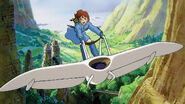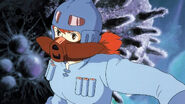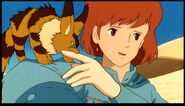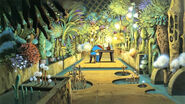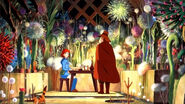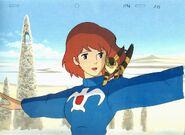Nausicaä is a fictional character and a princess who first appeared in Studio Ghibli's 1984 theatrical release, Nausicaä of the Valley of the Wind, as the main protagonist. She is the princess of the Valley of the Wind, a minor kingdom in a post-apocalyptic world.
Background
Physical Description
She is a young woman, petite build but extremely agile and fairly strong. Nausicaä has red hair with red earrings she wears dress-like military shirt. and beige trousers and long boots. At the end of the film she wears a pink dress that is dyed blue from the blood of the Ohmu.
Personality
Although a skillful fighter, Miyazaki's Nausicaä is humane, noble, brave, heroic, protective, sweet, serious, caring, kind and peace-loving. That said she is by no means a pushover, after witnessing her father's death she attacks his killers in a rage, an action that horrifies her later. She has an unusual gift for communicating with the giant insects, and is noted for her empathy toward animals, humans, and other beings. An intelligent girl, Nausicaä frequently explores the toxic wasteland which surrounds the kingdoms, and conducts scientific experiments in an attempt to define the true nature and origins of the toxic world in which she lives. Her explorations are facilitated by her skill at "windriding;" flying with an advanced glider-like craft called Mehve, equipped with a jet-engine.
Biography
She is princess of the Valley of the Wind and is loved by all its residents due to her kindness and loving care for all living things. Nausicaä is seemingly not scared of anything and always remains calm in any situation. Her determination and bravery save the valley and she is a role model to anyone. Nausicaä can read the wind extremely well like her father King Jihl, who is now bed-ridden due to slowly succumbing to the poison from the Toxic Jungle. She flies on a glider called a Mehve or Mowen.
Nausicaa has been a lover of animals all her life and once saved a baby Ohmu as a child. It was found by her father who took it away presumably to have it killed which upset Nausicaä tremendously. However, we learn later in the film the baby was released rather than killed. Nausicaä now has a pet fox squirrel who was rescued from the insects of the Sea of the Decay by Lord Yupa. His name is Teto and he comes everywhere with Nausicaä. Sometimes, Teto hides in her dress during action sequences or rides on her shoulder while she flies.
Nausicaä befriends the Pejite prince, Asbel, and saves both his life and helps his twin sister, Lastelle, although she dies despite Nausicaä's attempts to save her.
Nausicaä finally gives her own life in order to save the people of the Valley of the Wind from an Ohmu stampede. However, her bravery, courage, and compassion stop the Ohmu and she is resurrected by the insects. Upon her resurrection, Nausicaä thank the insects and walk through their glowing golden tentacles as though they were fields in her dress that is drenched blue by their baby's blood, unknowingly fulfilling the one thousand year old prophecy of the blue-cladded savior who will reconnect mankind with the Earth.
Development
The beginning of the character of Nausicaä is in an aborted project of Miyazaki's. He wished to adapt Richard Corben's Rowlf (about a princess protected by her dog) into an anime. Miyazaki found similarities with Beauty and the Beast which would inspire him to wish to create a character which highlighted the theme of "devotion, self-giving". Finding Corben's princess "bland", Miyazaki imagined "a young girl with character, brimming with sensitivity and contrasted with an incapable father". This character, named "Yala" (ヤラ) by Miyazaki, was a young princess who was "bearing the crushing weight of her destiny" when her sick father abdicated, leaving the burden of the kingdom to her, and having to bridle her personal aspirations. Miyazaki gave Yala a dog "which always accompanied her from a young age and especially cared for his mistress". This dog is found in many design sketches of Yala.
The transition of Yala to Nausicaä came when Miyazaki began to develop the character. Miyazaki intended Yala to wear short pants and moccasins, exposing her bare legs "to effectively show vigorous movements and a dynamic character", but was forced to abandon that idea as it did not make sense to expose her legs in the harsh environment in which Nausicaä was evolving. Around that time, Miyazaki began to like the name "Nausicaä", and he renamed the character.
Nausicaä's name comes from the princess Nausicaä in the Odyssey who assisted Odysseus. The Nausicaä of the Odyssey was "renowned for her love of nature and music, her fervid imagination and disregard for material possessions", traits which Dani Cavallaro sees in Miyazaki's Nausicaä. In English, the Greek name is normally pronounced /nɔːˈsɪkeɪ.ə/, but in the soundtrack for the film it is /ˈnɔːsɨkə/. Part of her character comes from a Japanese folk hero known as The Princess Who Loved Insects (虫めづる姫君, Mushi mezuru himegimi?), whose story appeared in the Tsutsumi Chūnagon Monogatari while another part was inspired by the writings of Bernard Evslin, as he had written a more in-depth extrapolation of the Odyssey's Nausicaä. Hayao Miyazaki, the creator of Nausicaä. The Princess Who Loved Insects was about a clever and beautiful princess who rather than beautifying herself and courting, would spend her time outdoors playing with bugs and caterpillars. Miyazaki has said that Evslin's Nausicaa reminded him of the princess who loved insects, and he wondered how the princess who loved insects lived her life after
him of the princess who loved insects, and he wondered how the princess who loved insects lived her life after the story ended. He said that the two characters "became fused into one and created the story". He also said that Nausicaä is "governed by a kind of animism". Miyazaki felt that it was important to make Nausicaä a female because he felt that this allowed him to create more complex villains, saying "If we try to make an adventure story with a male lead, we have no choice but to do Indiana Jones, with a Nazi or someone else who is a villain in everyone's eyes". Miyazaki said of Nausicaä that "[She] is not a protagonist who defeats an opponent, but a protagonist who understands, or accepts. She is someone who lives on a different dimension. That kind of person should be female, not male." When asked about Nausicaä's "vision and intellect far greater than other people's", her "distinguished fighting skills", and her leadership, including taking "the role of legendary savior", Miyazaki said that he wanted to create a heroine who was not a "consummately normal" person, "just like you or everyone else around you".
Nausicaä's affinity with the wind was inspired by translations of European geography books from the Middle Ages, where mastery of the wind was described as "witchcraft" and was feared and respected. Mills were described in these books as being used for "pushing sand dunes or grinding grain", which left an impression on Miyazaki. Inspired by the Earthsea cycle of Ursula LeGuin, Miyazaki coined the term kaze tsukai (風使い) as an alternative to Guin's "Master Windkey", which was translated into Japanese as kaze no shi (風の司) (lit. one who controls the wind).
Miyazaki had intended to make Yala more pulpy than his other female characters, a feature of sketches of her between 1980 and 1982. However, he realised that he could not draw Nausicaä nude without feeling like he should apologise, changing his idea of the story to be more "spiritual". When Miyazaki draws Nausicaä in poses which are a little "sexy", like the cover of Animage in March 1993, where Nausicaä smiles while wearing a torn tank top, he cautions that "Nausicaä never takes such a pose", however this does not prevent him from drawing her like this, saying "Well, if I hadn't drawn her as beautiful, there would have been some problems. I thought that I should settle down and draw her consistently, but every time I drew her, her face changed-even I was overpowered." He felt that over the 14 year run of the manga, rather than Nausicaa changing as a character, instead Miyazaki felt that he understood her better.
When Miyazaki is obligated to draw Nausicaä smiling for covers or character posters, he finds it difficult because "it does not match the character of [my] heroine". He does not like "representing Nausicaä as too radiant or with the attitudes typical of a heroine", and imagines that instead of this, when she is alone, she has a "serious [...] calm and collected" (but "not surly") attitude. He regards her "sombre and reserved" nature to be offset by her femininity. Miyazaki believes that characters like this, "far from being fulfilled [...] are the most altruistic."
The kana that Miyazaki chose to write Nausicaä's name in, ナウシカ (nauʃika), was that used by Yataka Kobayashi, the Japanese translator of Bernard Evslin's works. Miyazaki preferred it to the transcriptions of Nausicaä also in use, ノシカ (noʃika) and ノジカ (noʒika).
Helen McCarthy considers Shuna from Journey of Shuna to be prototypical to Nausicaä, and Dani Cavallaro feels Lana from Future Boy Conan and Clarisse of Castle of Cagliostro are also prototypical to Nausicaä.
Gallery

